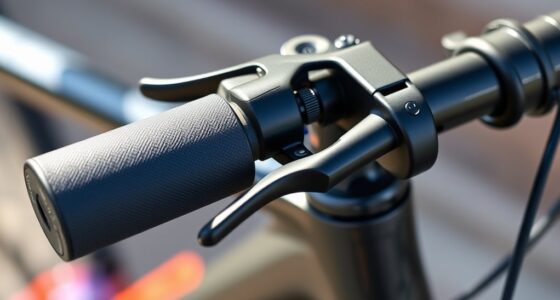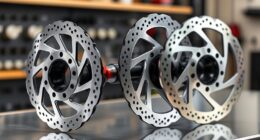The head tube angle is the tilt of your bike’s steering tube relative to the ground, influencing how it handles. A steeper angle (around 70°) makes your bike more responsive and easier to turn, perfect for quick maneuvers or racing. A slacker angle (around 65°) offers greater stability, great for downhill or rough terrain. Understanding this angle helps you choose a bike that matches your riding style and terrain, so keep exploring to learn more details.
Key Takeaways
- The head tube angle is the tilt of the steering tube relative to the ground, affecting bike handling.
- Steeper angles (~70°) make bikes more responsive and agile; slacker angles (~65°) enhance stability.
- It influences how easily the bike turns and maintains control on different terrains.
- Proper head tube angle ensures a comfortable, balanced ride suited to rider style and terrain.
- Understanding this angle helps in choosing or customizing a bike for optimal performance and safety.

Have you ever wondered how a bike’s steering and handling are influenced? One key factor is the head tube angle, which plays a significant role in shaping your riding experience. The head tube angle is part of the bike’s overall frame geometry, and it directly impacts how stable or responsive your bike feels when you’re on the road or trail. When you understand this angle, you can better grasp how it affects your riding stability and maneuverability.
Understanding the head tube angle helps you grasp your bike’s responsiveness and stability on any terrain.
In essence, the head tube angle is the tilt of the steering tube relative to the ground. A steeper angle, around 70 degrees, makes your bike more responsive and easier to turn quickly, which is ideal for racing or sharp cornering. Conversely, a slacker angle, closer to 65 degrees, provides more stability at high speeds and during downhill descents. This means your bike remains steady and predictable when riding over rough terrain or at high velocities. The difference in angles influences not only how your bike handles but also how comfortable and confident you feel while riding.
Frame geometry, including the head tube angle, directly influences riding stability. A more upright, stable feel is often achieved with a slacker head tube angle, which helps absorb shocks and maintain control on challenging trails or steep descents. On the other hand, a steeper angle enhances agility, making your bike more responsive when maneuvering tight turns or quick maneuvers. Your choice depends on your riding style and terrain preferences, but understanding this aspect of frame geometry allows you to select a bike that matches your needs.
The impact of the head tube angle isn’t limited to handling; it also affects the overall balance of your ride. A balanced setup ensures that your weight distribution feels natural, reducing fatigue and improving control. If the angle is too steep or too slack for your style, you might experience difficulty maintaining stability or responsiveness, which can compromise safety and comfort. Knowing how the head tube angle influences these elements helps you make informed decisions when choosing or customizing a bike.
Ultimately, the head tube angle is a subtle yet powerful aspect of bike design that influences how you experience riding. Whether you prefer quick, sharp steering or a stable, smooth ride, understanding this angle’s role in frame geometry allows you to optimize your bike’s handling characteristics. It’s about finding the right balance between agility and stability, ensuring your rides are enjoyable, safe, and tailored to your riding style. Recognizing the importance of frame geometry can help you select the best setup for your specific needs.
Frequently Asked Questions
How Does Head Tube Angle Affect Bike Handling?
A steeper head tube angle makes your bike more responsive to steering, giving you quicker handling and sharper turns, especially on smooth terrain. Conversely, a slacker angle provides more stability at high speeds and on rough surfaces. Frame geometry influences this, affecting how easily you can maneuver and control your bike. So, your head tube angle directly impacts steering responsiveness, shaping your riding experience based on your preferred terrain and style.
Can Changing the Head Tube Angle Improve Ride Comfort?
Imagine you’re riding your bike like a knight on a quest—changing the head tube angle can definitely boost ride comfort. By adjusting it, you improve your bike fit and steering responsiveness, making your ride smoother and less tiring. A more relaxed angle reduces strain, offering a comfy experience, especially on long rides. So, yes, tweaking the head tube angle can make your ride more enjoyable and tailored to your comfort needs.
What Is the Ideal Head Tube Angle for Racing Bikes?
For racing bikes, an ideal head tube angle is typically between 72 and 74 degrees. This setup maximizes aero efficiency by reducing drag and enhances frame stiffness for better power transfer. You’ll find this angle helps you stay aerodynamic and responsive at high speeds, giving you an edge in competitions. Adjusting within this range can fine-tune handling, so choose what feels most comfortable for your racing style.
Does Head Tube Angle Impact Bike Stability at High Speeds?
A wise cyclist once said, “Smooth seas do not make skillful sailors.” Your head tube angle definitely impacts bike stability at high speeds. A steeper angle improves aero efficiency, giving you that sleek, aesthetic appeal, but may reduce stability. Conversely, a slacker angle enhances control, especially on rough terrains. So, choose your angle based on your riding style to find the perfect balance between speed and stability.
How Do Head Tube Angles Differ Between Mountain and Road Bikes?
You’ll notice mountain bikes typically have steeper head tube angles around 65-68 degrees, offering quick steering responsiveness for rough terrains. In contrast, road bikes feature more relaxed angles, usually between 70-73 degrees, providing stability at high speeds. These differences in frame geometry directly influence steering responsiveness, making mountain bikes agile for technical trails, while road bikes prioritize smooth handling and control on paved surfaces.
Conclusion
Understanding head tube angles is like tuning a musical instrument—you get the harmony just right for your ride. When you know what those angles mean, you can steer your bike with confidence, whether you’re carving corners or cruising straight. Remember, it’s not just numbers; it’s the secret sauce that influences your bike’s personality. So, embrace these angles, and let your ride sing smoothly down every trail and street ahead.








